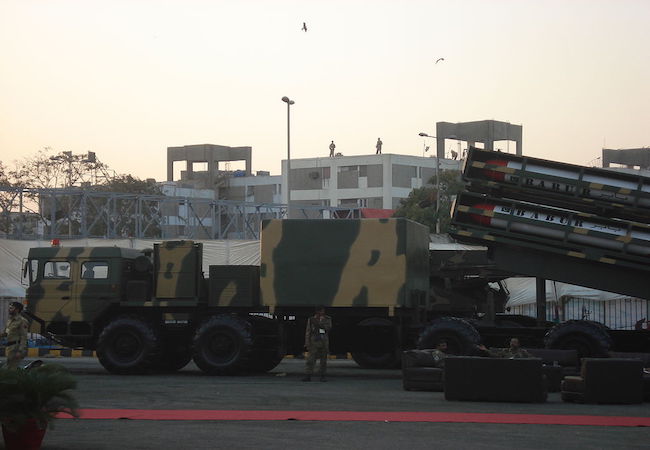
By Ahyousha Khan
It is to be said that advent of Multiple Independently Targetable Re-entry Vehicles (MIRVs) will intensify the strategic competition in South Asia. South Asia is home to belligerent Nuclear Neighbors that are continuously involved in conventional and non-conventional military build-up to achieve security against each other. But, what is making the region more significant, in the eye of International community is nuclear arms race and lack of escalation control mechanism between India and Pakistan. Recent development of Ballistic Missile Defenses by India to secure credibility of its deterrence has cause ripple effects and MIRV technology is by-product. MIRVs are considered as a technological solution to counter BMDs aside cruise missiles. So, owning to the mentioned fact, Pakistan developed and tested its first MIRV named Ababeel in January 2017. As MIRVs are considered as hard target kill, it means they must not only by very accurate but they also should entail numerical value to totally destroy enemies’ hardened silos. In addition MIRVs are considered as force multipliers because they entail many missiles in one delivery vehicles. So far MIRV technology is only achievable in ballistic missiles.
Considering Indian technological capabilities regarding hard target kill and its BMD program, development of MIRV by Pakistan was matter of time. Even then, Pakistan is criticized by international community for developing MIRVs because they are viewed as hard-target-kill weapons and have potential to change nuclear deterrence postures. Moreover, it is also believed that MIRVs play role in intensifying the arms race because more number of missiles are required in one weapon. In view of, unstable strategic stability in South Asia International scholars consider development of MIRV as offensive move. Furthermore, they fear that MIRVs give rise to pre-emptive strikes options to avoid destruction of one’s own nuclear arsenals.
However, whatever Pakistan has done so far to strengthen its forces is actually an attempt to secure itself from Indian Ambitiousness. Whether we look into the decision of going nuclear or developing low yield weapons, every action was defensive rather than Offensive. Rationale behind development of offensive technology like MIRVs by Pakistan also lies in securing the credibility of its deterrence against India. So far, Pakistan is doing everything in its reach to make nuclear deterrence work against enemy that is ambitious to outgrow it.
Therefore, Pakistan has developed MIRVs because India possesses the capability of MIRVing, though it has not officially tested and declared it. But, when it comes to security matters states access their enemies on the basis of capabilities not intentions and this is what Pakistan is been doing. Moreover, with advanced ISR capabilities, space program and dual capable deliver systems India already has edge that is destabilizing for nuclear deterrence between both states. In addition, BMD by India against Pakistani ballistic missiles is damaging to credibility of Pakistan’s delivery vehicles; that are tasked to reach in enemy’s area during any conflict or war.
Internationally, whenever Pakistan has elaborated its threat perception vis-à-vis India, it has face criticism on being Indo-phobic. But, if Indian Military developments – infatuation with surgical strikes, SSBNs, CSD, ISR and Cyber capabilities- are to be analyzed, one can not reject the Pakistani claim regarding its security threats from India.
Furthermore, MIRVs were established by soviets and USA because of their cost effectiveness against spending large amounts construction of massive missile launcher. India developed BMD because it is huge economy and has vast resources unlike Pakistan. In response MIRVs are developed by Pakistan, which not only ensures element of credibility in Pakistan’s deterrence posture but were also cost-effective considering small economy of Pakistan. So, why economical option that world powers like US and USSR utilized, should not be considered by Pakistan, when its nuclear deterrence is under stress from growing Indian capabilities.
MIRVing by Pakistan is considered as destabilizing, but there are other subjective interpretations of the situations. Mostly, these interpretations are not brought under the light by International spectators. As far as South Asian strategic stability is concerned, Pakistan’s MIRVing capability is positive addition. It will provide Pakistan with options that were not available to Pakistan before, regarding retaliatory capabilities and to keep India at bay Pakistan has to rely on low yield weapons. Moreover, regional instability is linked with offense-defense imbalance, with the development of MIRVs by Pakistan, both states are enjoying balance vis-à-vis each other. Situation would have been threatening, if one of the rivals -India or Pakistan- didn’t have MIRV capability against other.
Last but not least, to develop MIRV technology at it’s fullest for strengthening the credibility of nuclear deterrence, Pakistan need to invest in its space programs.
Ahyousha Khan is a Research Associate at the Strategic Vision Institute in Islamabad, Pakistan




